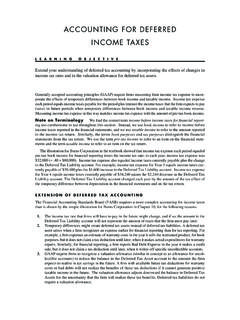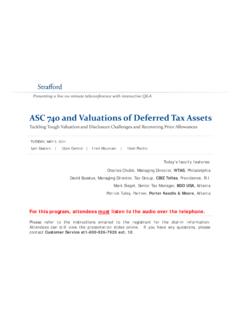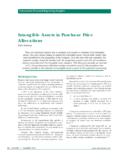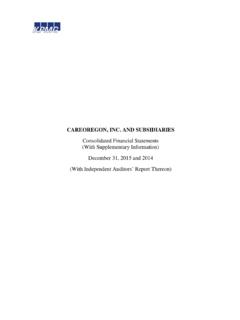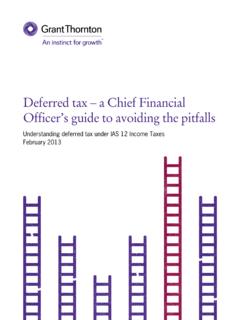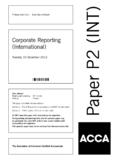Transcription of Deferred tax assets and liabilities: tax benefits ...
1 Journal of Finance and Accountancy Deferred tax assets and liabilities : tax benefits , obligations and corporate debt policy Christine Harrington The University of Tampa Walter Smith The University of Tampa Donald Trippeer SUNY Oneonta ABSTRACT. Prior studies have indicated that book-tax reporting differences influence corporate debt policy. However, observation of the sources of book-tax differences is often difficult due to lack of disclosure or may require hand collection. To capture temporary book-tax differences, this paper proposes to harness the information in net Deferred tax assets / liabilities (NDTA/L). reported on the balance sheet and available in Compustat. The NDTA/L directly measures future expected changes in tax payments that will likely affect the firm's future marginal tax rate.
2 This study considers how the NDTA/L, as a composite measure of temporary non-debt tax benefits /obligations, influences debt policy when firms make financing decisions. A NDTA/L is present in 37% of the observations in a sample of public corporations from 1994-2008. Consistent with the substitution hypothesis, the results indicate that firms with NDTA are significantly less likely to issue debt at a refinancing point and have lower leverage ratios following a refinancing. Similarly, firms with NDTL are more likely to issue debt and tend to have higher leverage after a refinancing. The NDTA/L helps alleviate the problem of identifying individual non-debt tax shields because it bundles the probable net tax effects of temporary book-tax differences.
3 Keywords: capital structure, debt, leverage, Deferred tax asset , tax shield Deferred tax and debt, Page 1. Journal of Finance and Accountancy INTRODUCTION. There is growing evidence that book-tax earnings differences influence corporate capital structure. Much of this research is motivated by DeAngelo and Masulis (1980), who have suggested that corporations use non-debt tax shields to substitute for the tax benefits of debt ( , MacKie-Mason, 1990; Graham, Lang, & Shackelford, 2004; Kahle & Shastri, 2005;. Graham & Tucker, 2006; Wilson, 2009; Lisowski, 2010; Shivdasani & Stefanescu, 2010). Book-tax earnings differences (BTDs) arise from several sources and may be either temporary or permanent. Normal BTDs may occur because of differing GAAP and tax treatments of revenues and expenses.
4 BTDs may also result from deliberate attempts to defer or avoid taxes that range from full legal compliance to pushing the envelope of tax law (Hanlon & Heitzman, 2010, p. 137). A number of studies suggest that BTDs are strategically managed to either avoid/defer taxes through sheltering ( , Wilson, 2009), avoid/defer tax payment through tax planning ( , Ayers, Jiang, & Laplante, 2009), or manage earnings ( , Phillips, Pincus, &. Rego, 2003). Observability of the components of BTDs is a major obstacle to understanding how non- debt tax shields (NTDS) influence leverage. First, corporate tax return information is private. Second, public corporations are not required to fully disclose the sources of BTDs. For temporary BTDs, SFAS 109 requires disclosure of only the major items used to determine the periodic Deferred tax expense, and the items disclosed are often choice variables (Hanlon & Heitzman, 2010).
5 Lack of transparency regarding temporary BTDs has resulted in focus on individual ( , tax loss carryforwards in MacKie-Mason, 1990) or aggregate ( , book-tax spreads in Schallheim & Wells, 2006) measures of NDTS. Studies based on unconventional samples have shown that off-balance sheet NDTS have a significant impact on leverage decisions. Graham and Tucker (2006), Frank, Lynch, and Rego (2009), Wilson (2009), and Lisowsky (2010) have presented evidence that firms with tax shelters use less debt compared to control firms. Graham, et al. (2004), Kahle and Shastri (2005), and Shivdasani and Stefanescu (2010) have suggested that book-tax differences arising from employee compensation serve as NDTS. Graham and Leary (2011) have argued that missing NDTS variables potentially bias the understanding of the cross-sectional variation in leverage.
6 This paper addresses the concerns of observability and potential omitted variable bias in studies of capital structure by examining how net Deferred tax assets and liabilities (NDTA/L). influence debt issuance decisions and leverage of public corporations. The NDTA/L is a summary measure of the total estimated future tax benefit/obligation attributable to temporary differences and carryforwards after elimination of future benefits not likely to be realized (FASB. 109). Prior studies provide rich detail on how individual tax shields influence leverage decisions ( , MacKie-Mason, 1990; Graham, et al., 2004; Kahle & Shastri, 2005; Shivdasani &. Stefanescu, 2010). MacKie-Mason (1990) has argued that tax shields only matter through their effect on the firm's marginal tax rate.
7 The NDTA/L directly measures future expected changes in tax payments that will likely affect the firm's future marginal tax rate. Similar to prior studies (Hanlon, 2005; Blaylock, Shevlin, & Wilson, 2010), this study focuses only on temporary BTDs because of the difficulty in observing permanent BTDs. The empirical tests in this paper are in the context of the dynamic trade-off theory in which capital market frictions lead to relatively infrequent rebalancing of capital structure (Fischer, Heinkel, & Zechner, 1989; Leary & Roberts, 2005; Strebulaev, 2007). Consistent with the dynamic trade-off theory, the sample in this paper is limited to firms at a refinancing point, Deferred tax and debt, Page 2. Journal of Finance and Accountancy or when firms issue (retire) debt or issue (repurchase) equity.
8 Around 37% of sample firm years have a NDTA/L. Conditional on being at a refinancing point, firms are predicted to issue less (more) debt when a NDTA (NDTL) is available. The influence of the NDTA/L on the cross- sectional variation in leverage is also examined, again conditional on firms being at a refinancing point. Firms are predicted to have relatively less (more) leverage when a NDTA (NDTL) is available. The empirical tests strongly support both predictions and are robust to alternative measurements of security issues, leverage, and estimation techniques. This paper contributes to the capital structure literature by demonstrating that temporary BTDs in the form of NDTA/L influence debt issuance and leverage decisions. Recent studies suggest that off-balance sheet NDTS are relatively important to understanding the cross-sectional variation in leverage ( , Graham & Tucker, 2006; Shivdasani & Stefanescu, 2010) yet are difficult to capture using standard research data.
9 The NDTA/L contains the complete set of realized Deferred tax items from temporary and carryforward sources. This variable arises from differing treatments for tax and financial reporting and is a running total of future tax reductions (obligations) that have occurred up through the date of the balance sheet. The NDTA/L is on- balance sheet and is readily available to researchers in Compustat. Further, the NDTA (NDTL). reflects the monetary value of probable future tax reductions (obligations) that potentially influence the future marginal tax rate. The NDTA/L captures only temporary BTDs; however, the measure is a step forward in explaining corporate leverage when information on sources of BTDs is difficult to obtain. The findings in this study support the notion that non-debt tax shields substitute for the tax benefits of debt (DeAngelo & Masulis, 1980).
10 By limiting the sample to firms at a refinancing point, the results in this study support the predicted positive relationship between profitability and leverage in the dynamic trade-off theory (Strebulaev, 2007). Similar to Harford, Klasa, and Walcott (2009), this paper provides additional evidence related to the existence of leverage targets. The results in this paper suggest that when at a refinancing point, firms with leverage exceeding historical averages are less likely to issue debt, and vice versa. The paper proceeds as follows. In section two the NDTA and NDTL are described and related to prior studies that examine the influence of non-debt tax shields on debt policy. The empirical hypotheses are developed in section three. The research method is explained in section four.










